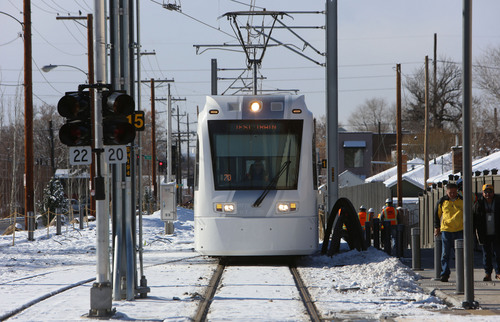This is an archived article that was published on sltrib.com in 2013, and information in the article may be outdated. It is provided only for personal research purposes and may not be reprinted.
Imagine this, Salt Lake City transit riders: a bus or train every 10 minutes at every stop; getting from point A to point B with a maximum of one transfer; and only a quarter mile from home or work to at least two transit routes.
Sound too good to be true?
The Salt Lake City Council thinks not and identified those items among its transit goals as it seeks to establish a "Transit Master Plan" that promotes a future of clean air, economic development and a lifestyle independent of cars.
None of that is possible, of course, without the Utah Transit Authority. And the agency is under no obligation to fulfill the city's wish list.
"We know it won't happen tomorrow," Council Chairman Kyle LaMalfa told UTA officials last week.
Nonetheless, the City Council wants UTA to know what it seeks as it moves toward a citywide "Transit Master Plan" that will identify future bus, streetcar and light rail routes.
Salt Lake City, in conjunction with the transit agency, will commission a study that city officials say will lead to such a plan. The municipality will spend $150,000 and UTA will pick up the balance of the $350,000 total.
Two questions stand out: Once the consultants produce the study — about 18 months from now — will Salt Lakers accept it more readily than a previous consultant's report that selected 1100 East as the extension of the Sugar House Streetcar?
And will the cash-strapped transit agency move forward with Salt Lake City's goals when UTA must also consider the needs of numerous other communities along the Wasatch Front?
"The study should bring UTA and Salt Lake City closer together," LaMalfa said in an interview. He added the transit agency has been responsive to Salt Lake City's desire to enhance mass transit.
He provided two examples: The $360 per year mass transit pass available to all Salt Lake City residents beginning in January; and the Sugar House Streetcar that opened Dec. 8 (South Salt Lake also was a partner in the streetcar venture).
Councilman Charlie Luke agreed that "it makes sense to involve UTA early on in the master-plan process. This is our opportunity to let them know what it is we need in Salt Lake City for our residents."
Nonetheless, the master-plan process is fraught with challenges, said Councilman Luke Garrott. The parameters of the study must be clearly outlined before a consultant is commissioned, he said.
As recent history suggests, such transit studies can be problematic.
The city paid $150,000 for the study that identified 1100 East from 2100 South to 1700 South as the preferred extension of the Sugar House Streetcar line. That proposal pushed by Mayor Ralph Becker and supported by a majority of the council lacks broad popular support and remains controversial.
In a brief exchange at a Dec. 2 City Council work session, Garrott told city transportation director Robin Hutcheson that the council's goals must be included in language guiding the proposed citywide transit study.
"The study includes assessing demand for different types of transit, examining corridors and nodes where additional transit would be suitable and also will include strategies to improve convenience and comfort," according to a statement from Hutcheson.
Set to start early next year, the study will encompass "an extensive public process," she said.
"The transit plan will also consider the relationship between land use and transit by looking at where our current land uses would already support adding more transit, as well as how transit might catalyze land-use changes around certain nodes," she said.
UTA has laid 70 miles of rail line in the past seven years. And while light rail has been a big success, bus service in some Salt Lake City neighborhoods has suffered, Luke said.
"If we really want to create a lifestyle change, we're going to have to change routes and make them usable," he said. "We don't have a usable system for all residents now."
At a joint meeting between the City Council and the UTA board of trustees this week, general manager Michael Allegra said after years of construction the transit agency is refocusing on "ridership and reliability."
"We seem to be doing more and more each year, ridership and service-wise," he said. "A lot of things you will see in our future are community and economic development, as well as transportation."



